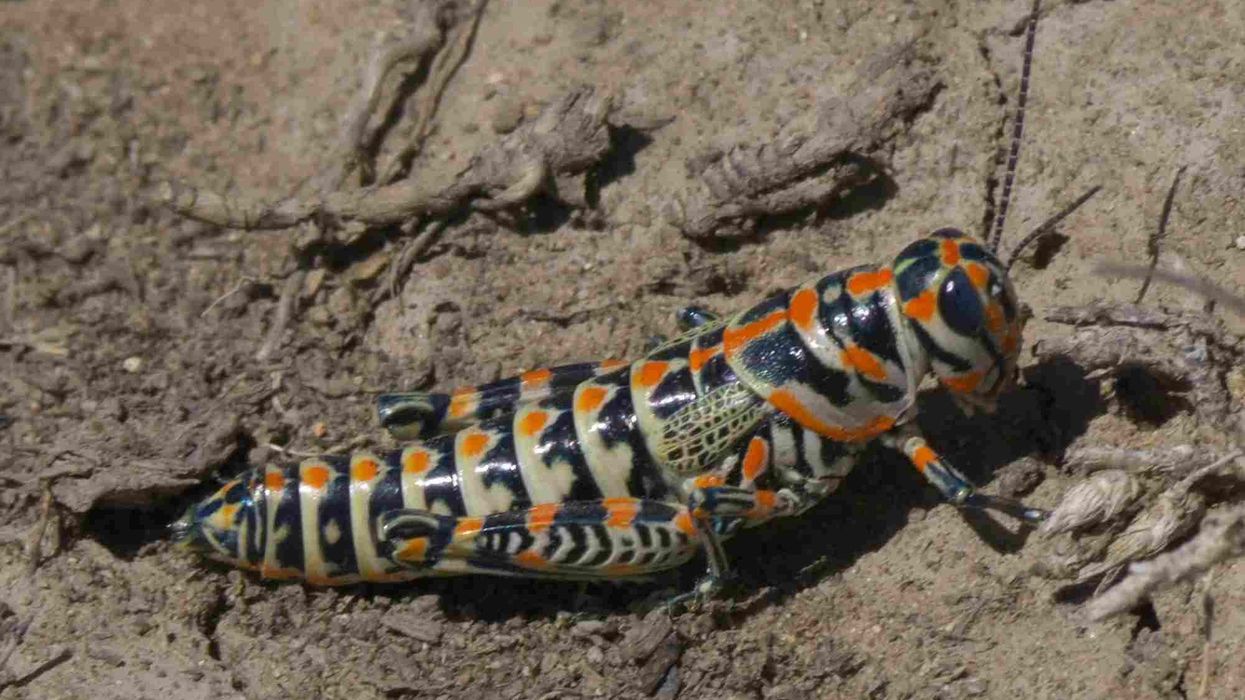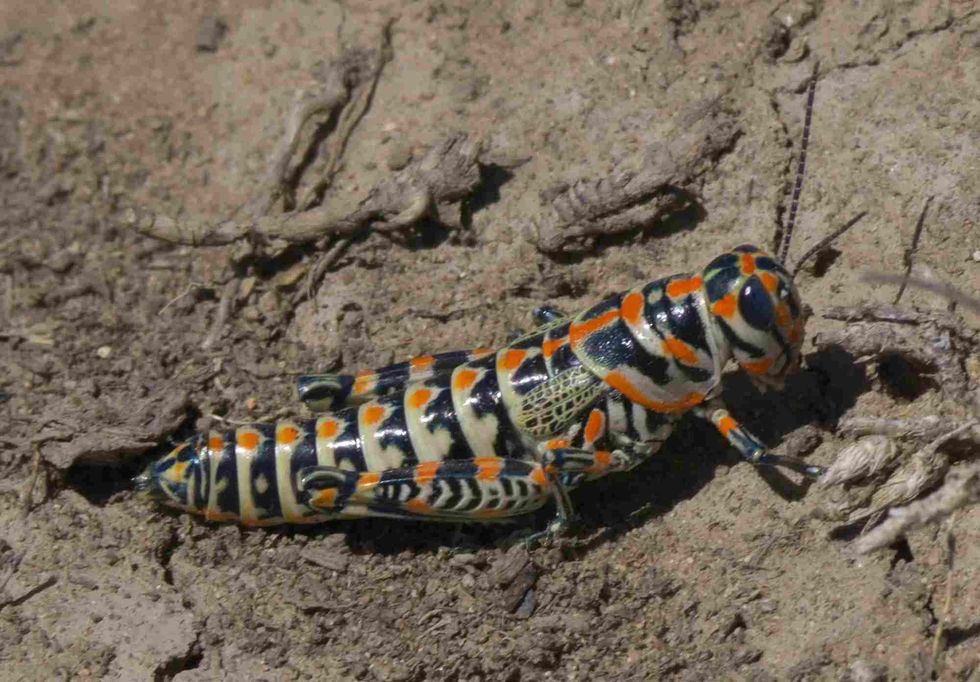If you ever visit the desert in western America, then you are bound to run into various animals in the area! The rainbow grasshopper is a well-known resident of the desert regions of America, such as New Mexico and Arizona.
It is also known for its variety of colors such as green, blue, red, and yellow. These colors help this creature blend into the demanding habitat of the desert and of course, avoid the many larger predators who live in the same climate as them.
They eat the leaves on various shrubs and bushes. They primarily live in small burrows and hideouts, coming out only at night to feed on leaves.
During the day, they can be occasionally found on rocks, under bushes, and shrubbery. They are usually found living by themselves, coming together only for mating season.
The world is full of many amazing animals and insects you can see and learn more about! Go on and read all about this grasshopper, or you can learn all about other creatures like the woodlouse and the giant water bug.
Rainbow Grasshopper Interesting Facts
What type of animal is a rainbow grasshopper?
The rainbow grasshopper (Dactylotum bicolor) is a type of grasshopper.
What class of animal does a rainbow grasshopper belong to?
The rainbow grasshopper (Dactylotum bicolor) belongs to the class of arthopods.
How many rainbow grasshoppers are there in the world?
The precise number of rainbow grasshoppers is unknown. Grasshoppers dwell in grassy places such as meadows, fields, forests, and woodlands. There are an estimated 11,000 grasshopper species on the planet. All grasshopper species, like all bugs, have a three-part body made up of the head, thorax, and abdomen.
Where does a rainbow grasshopper live?
The rainbow grasshopper (Dactylotum bicolor) lives in the savannah which is desert grassland. They prefer warm climates, dry grasslands, and deserts.
What is a rainbow grasshopper's habitat?
This rainbow grasshopper (Dactylotum bicolor) habitat range extends from the western Great Plains of the USA, as well as regions of Canada, especially towards the southern side of the nation. In the United States, you can find them towards the south in Arizona, Texas, New Mexico, and northern Mexico.
You can find these grashoppers in desert grasslands, short grass prairie, thinly vegetated regions, and alfalfa farms.
Who do rainbow grasshoppers live with?
This species of painted grasshopper is solitary and only comes together to breed. This is different to adult oriental cockroaches that are considered pests. They live in packs or with other cockroaches. Insects are species that prefer to live in groups and do all chores together, such as obtaining or collecting food due to their small size.
How long does a rainbow grasshoppers live?
These grasshoppers in the genus Dactylotum live for around one year. This is relatively average in terms of a lifespan compared to other creatures.
How do they reproduce?
Grasshopper-painted eggs are deposited in batches of roughly 100 eggs in soft soil. Adults are present until September or October, with overwintering and hatching in spring or summer.
Each year, there is only one generation. Though adult rainbow grasshoppers are typically polyphagous, meaning they eat various plants, the nymphs born in New Mexico and Arizona only eat Wright's false willow.
In addition, nymphs have been discovered to orient themselves depending on the sun, placing themselves around the shrub to thermoregulate. This means to maintain their body temperature at a satisfactory range.
Female stag beetles produce eggs that hatch into larvae and remain underground and eat rotting wood until pupating.
What is their conservation status?
The conservation status of the rainbow grasshopper is categorized as Least Concern by the IUCN Red List. The IUCN does not presently place the rainbow grasshopper (Dactylotum bicolor) on the Red List of Threatened Species because they are sufficient in numbers.
Rainbow Grasshopper Fun Facts
What do rainbow grasshoppers look like?
Males and females of Dactylotum bicolor grasshoppers reach an average length of 0.8 in (20.3 mm) and 1.4 in (35.5 mm), respectively. This grasshopper has a predominantly black body with reddish and yellowish patterns, a light green prothorax, and light green wingtips.
There are six to eight spines found on the tibia of the rear legs. This species lacks wings and is incapable of flying. The hue of the insect varies depending on its distribution range.
How cute are they?
This insect in the genus Dactylotum native to North America is remarkably beautiful. In its own way, it is incredibly colorful with vibrant colors. This lovely insect has a vast endemic habitat range, good for individuals who enjoy its beauty.
How do they communicate?
As grasshoppers are insects, they are unable to communicate vocally. They do, however, interact visually and audibly. Mole crickets have been observed communicating with one another through song. Mole crickets adopt a unique stance in the tunnel they construct by burrowing into the soil surface, which aids in amplifying and reverberating the mole cricket's voice.
How big is a rainbow grasshopper?
The length range of rainbow grasshopper is about 1.4 in (35.5 mm). In comparison, adult praying mantises are 1.95-2.93 in (5-7.4 cm) long. Therefore, the praying mantis species is much larger than rainbow grasshoppers.
How fast can rainbow grasshoppers move?
Unlike most other comparable organisms on the planet, this arthropod lacks wings and is unable to fly.
How much does a rainbow grasshopper weigh?
Adult rainbow grasshoppers weigh roughly 0.01 oz (0.28 g).
What are the male and female names of the species?
Male and female species of this Texas rainbow grasshopper do not have any specific name.
What would you call a baby rainbow grasshopper?
There is not any special name for a baby rainbow grasshopper found in Costa Rica.
What do they eat?
Though adult rainbow grasshopper are polyphagous, meaning they feed on various plants, nymphs born in New Mexico and Arizona only feed on Wright's false willow (Baccharis wrightii).
Are they harmful?
Though many brightly colored insects use color and design to signal toxicity, the painted grasshopper is not one of these. The painted grasshopper is also referred to as the barber pole grasshopper or the rainbow grasshopper. However, there is no indication that these grasshoppers are harmful to people or animals or carry diseases that could damage humans.
Would they make a good pet?
These colorful grasshoppers are a good alternative for individuals looking for a pet bug with basic requirements. They often feed on readily accessible foliage, require no particular equipment or a large tank, and are unlikely to frighten visitors.
Did you know...
Grasshopper sparrows do not normally fly in a straight line. Instead, they fly in a zig-zag manner before diving into the shelter provided by tall grasses, allowing them to avoid any predators that may be pursuing them to the nests.
What is the real color of the rainbow grasshopper?
It has a mostly black body with reddish and yellow patterns and a light green prothorax with pale green wing pads.
Where does the rainbow grasshopper come from?
Dactylotum bicolor, also recognized as the rainbow grasshopper, barber pole grasshopper, or the painted grasshopper, is a species of grasshopper that belongs to the family Acrididae. It is native to the United States, northern Mexico, and Canada. It is aposematic, meaning that it has a warning coloration to keep predators away.
Here at Kidadl, we have carefully created lots of interesting family-friendly animal facts for everyone to discover! For example, learn more about some other arthropods from our praying mantis facts, or stag beetle facts for kids.
You can even occupy yourself at home by coloring in one of our free printable rainbow grasshopper coloring pages.










